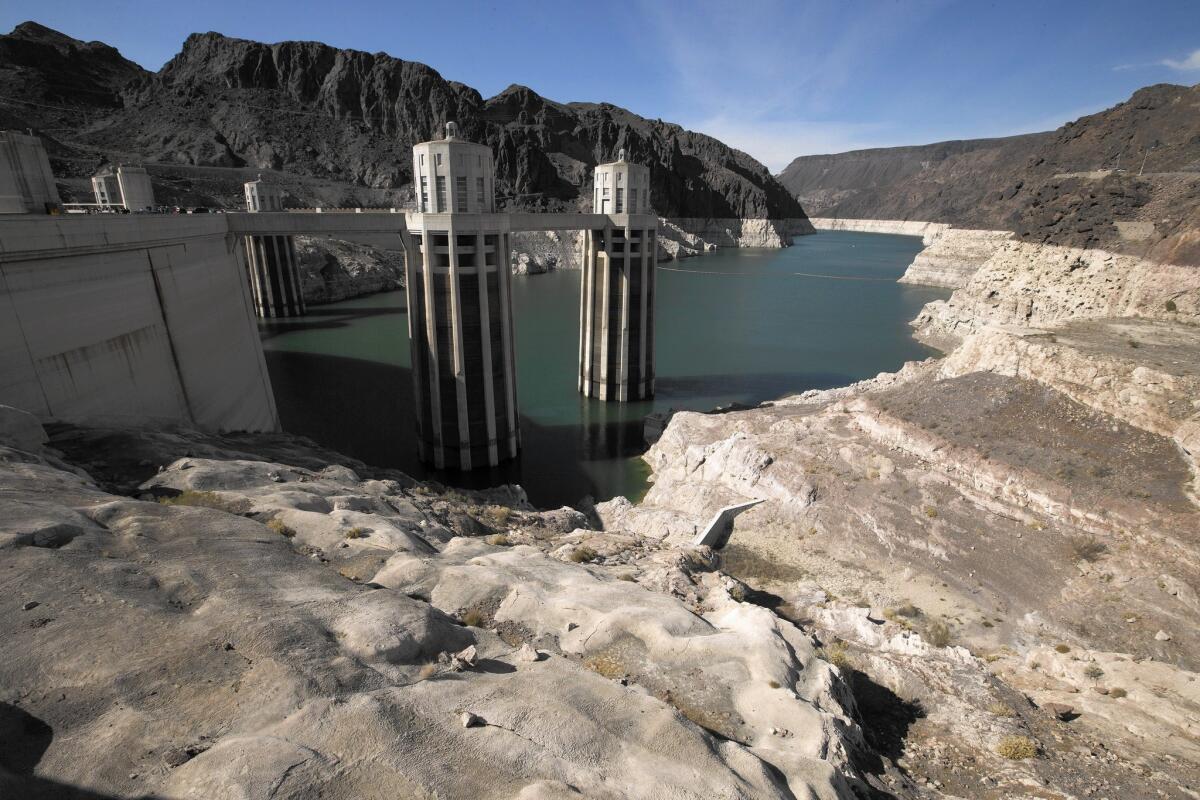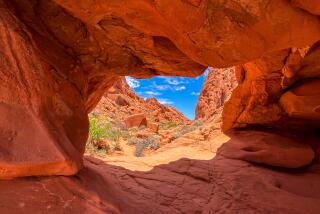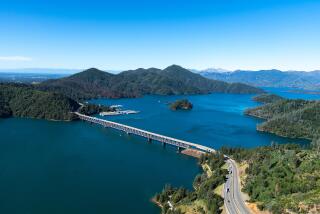Lake Mead hits a new low, but the drought has a silver lining -- tourism

Lake Mead and Hoover Dam. In September, the third and deepest intake pipe into the lake will be opened to ensure that Las Vegas-area consumers have water no matter how far Mead falls.
Reporting from BOULDER CITY, Nev. — Bruce Nelson was just a baby when Lake Mead was at its mightiest.
That was 1983 — ancient history to the 32-year-old whose family has run marinas here for three generations — when the lake gushed over Hoover Dam like a desert Niagara Falls.
But that was then. Now, the West remains mired in a lingering drought that has sapped the lake level to its lowest point since Mead was created in the 1930s.
The drop has threatened water supplies for the entire Southwest, prompting officials to consider rationing. In September, the third and deepest intake pipe into the lake will be opened to ensure that Las Vegas-area consumers have water no matter how far Mead falls.
But Nelson says those already penning Lake Mead’s obituary are a bit premature.
Tourism here is rebounding and the drought has brought an odd bonus: As waters recede, the lake has given up long-submerged secrets — a ghost town and B-29 bomber among them, history slowly revealed with the gentle care of an archaeologist’s brush.
On a recent Friday, Nelson shuts off the engine of his Yamaha pleasure boat and floats in the aqua-green waters just off the dam wall. On either side of him, the rock face soars toward impossibly blue summer skies. Nelson’s family opened their first marina here in 1957, and he grew up on this lake. His childhood playground now supports his livelihood.
“It’s just so unfair to say this lake is disappearing,” he says. “The lake is what it is. Do we prefer more water? Sure. But even with less water, this is still one big, big lake.”
Nelson has stopped in a place called Black Canyon, though its walls now bear the black-white contrast of a piano keyboard.
The chalk-colored stone closest to the waterline, covered with residue from the retreating waters, is a measuring stick of just how far the lake level has fallen — from 1,226 feet to 1,075 feet in just 17 years, with most of that in the last few years.
------------
FOR THE RECORD
July 6, 12:07 p.m.: An earlier version of this story said the water level at Lake Mead fell from 2,026 feet to 1,075 feet. Actually, the high water mark was 1,226.
------------
Still, Lake Mead National Recreation Area remains the sixth most popular destination of the nation’s 407 national parks. With 7 million annual visitors, it draws more than the Grand Canyon, Yosemite or Yellowstone.
Overall tourism here has plummeted 20% since 1998, when the water level began dropping, but recent trends are encouraging.
Park officials say spring attendance was up 47% from the same time the year before. So far this summer, attendance is up 30% compared with a year earlier.
Park officials credit the rise in part to the reviving economy. Nelson attributes the rebound to a scenic 450-mile shoreline that would stretch from San Diego north to Monterey.
Nelson jets his craft around the lake’s shoreline, through inlets that have long been below water but are now being explored by boaters and swimmers.
There’s the ghost town of St. Thomas, a former Mormon settlement founded 150 years ago and abandoned in 1938 as the converging Virgin and Muddy rivers filled a basin whose southern terminus was plugged by the Hoover Dam.
The town on the lake’s northernmost finger near Overton began resurfacing a decade ago and has become so popular with hikers that park officials plan to install a series of information placards there.
Nelson motors past once-submerged land masses such as Boulder Island — and others without names — that sit just offshore from the Las Vegas Boat Harbor.
A few years ago, boats could ease through the two peaks that jutted skyward a few feet above the waterline, each marked by a green buoy. Now the girth of the land below is exposed, like a belly or the monstrous lower portion of an iceberg. The towering rock now serves as a windbreak for the marina.
Nelson whips the Yamaha boat past the inactive Batch Plant, a circular-shaped facility that washed aggregate for the concrete used to make the Hoover Dam. Once accessible only to underwater divers, parts of the plant sit 50 feet out of the water.
Recreational divers are now converging on another oddity: a World War II-era bomber that sank during a 1948 test-landing accident.
While the wreck of the B-29 once rested beneath 260 feet of water, the site now lies just 120 feet below the surface. “The ambient light makes this a more interesting dive,” says Joel Silverstein, owner of Scuba Training and Technology, which leads tours to the wreck.
Silverstein has seen an uptick in clientele, but he still worries about the health of the lake. “The lower level of the lake is disturbing. That we’re able to go look at stuff now in shallower depths is the dark cloud’s silver lining.”
Christie Vanover, a spokeswoman for the Lake Mead National Recreation Area, sees Lake Mead’s water level like a bank account. “Water is money. Sometimes there’s ample money and sometimes there’s not. That’s when we’re not getting deposits from Lake Powell upriver and people downstream are making withdrawals.”
Park managers are even contemplating the once-unthinkable: the 950-foot water mark, now just 125 feet away. “We originally discussed 1,000 feet and then dropped to 950,” Vanover said. “When we did that there was a moment of silence, like, ‘Could we ever reach that level?’”
In beach areas, each 1-foot drop in water level exposes 30 feet of new shoreline. For Mead officials that has meant continually lengthening asphalt boat launches at half a dozen locations around Mead, which straddles Nevada and Arizona. In the last decade, officials have spent $36 million in launch construction and plan on spending another $2.3 million in 2015.
In 2007, officials relocated one marina — boats, berths and all. At others, the water line is so far away from public parking that managers use golf carts to ferry mariners to and from their boats.
Nelson, however, insists on seeing what’s there, not fretting about what isn’t.
As he guns his boat across open waters, he calls Mead a boater’s lake, with many of its hidden shores and attractions reachable only by water. On this day, Mead’s very existence seems improbable: a clear body of water surrounded by parched desert, a lunar landscape marked by black volcanic and red rock, and designated wilderness areas.
Nelson slows his boat inside isolated Wishing Well Cove, where the lowering water level has exposed a panorama of overhanging rock walls, under which several children paddle about on a rubber raft.
He slowly turns the boat beneath a now-dead quagga mussel, an invasive species that clings to a rock face once well below water.
Nearby, a single duck bobs contentedly, as though unaware of the encroaching lake floor below.
john.glionna@latimes.com
Twitter: @jglionna
MORE DROUGHT NEWS:
Water agencies baffle conservationists with water use surge
Drought puts California pool repairman who works underwater in high demand
Drought drives greater household use of gray water
More to Read
Sign up for Essential California
The most important California stories and recommendations in your inbox every morning.
You may occasionally receive promotional content from the Los Angeles Times.











